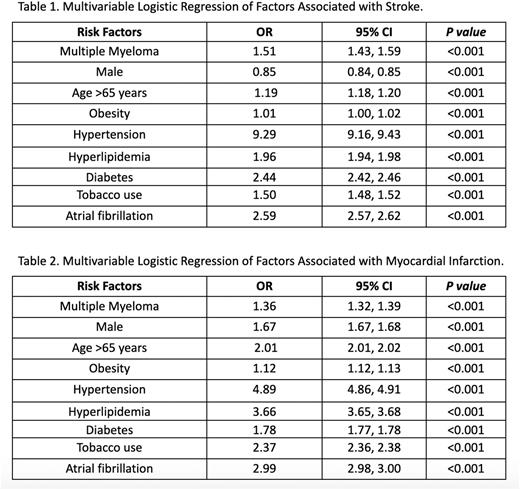Abstract
Background: Multiple myeloma is defined by an aberrant increase in monoclonal immunoglobulins, accounting for approximately 10% of all hematologic malignancies. Patients with multiple myeloma have a high risk of arterial and venous thrombosis, which is hypothesized to be due to the interplay of patient comorbidities, therapy, and tumor-related factors. Real-world studies evaluating the association of multiple myeloma and arterial thrombosis in the United States (US) are scarce. Therefore, we conducted a study to assess the risk of stroke and myocardial infarction in this population of patients.
Methods: We performed a retrospective study by querying a US-based database (Explorys, IBM) that retrieves patient records from 26 healthcare systems across 50 states, representing around 80 million patients. The database employs Systematized Nomenclature of Medicine - Clinical Terms (SNOMED CT) for diagnosis codes. From 1999 through 2022, we identified patients diagnosed with multiple myeloma who were 18 years or older. We also evaluated the following risk factors for stroke and myocardial infarction; sex, age > 65 years, hypertension, hyperlipidemia, diabetes mellitus, smoking status, and atrial fibrillation. A multivariable logistic regression accounting for all covariates was investigated to test for the risk of stroke and myocardial infarction. Results were reported in odds ratio (OR) and 95% confidence interval (CI), and the result was considered statically significant if the p-value was less than 0.001.
Results: A total of 70,434,190 patients were included. 67,920 patients had multiple myeloma; 77% were aged > 65, and 52% were male. 19% had obesity, 67% had hypertension, 53% had hyperlipidemia, 31% had diabetes, and 21% had atrial fibrillation. A total of 600 patients had stroke with a prevalence of 0.88% and 5,370 patients had myocardial infarction with an incidence of 7.9%. After adjusting for confounding risk factors, the risk of stroke was significantly higher in the multiple myeloma group compared to patients without multiple myeloma (OR 1.51, 95% CI 1.43-1.59) see table 1. The risk of myocardial infarction was also significantly higher among patients with multiple myeloma (OR 1.36, 95% CI 1.32-1.39) see table 2.
Conclusion: This is the largest real-world study in the US evaluating the risk of arterial thrombotic events in patients with multiple myeloma. Our study showed 51% and 36% higher odds of having a stroke and myocardial infarction, respectively. Given the enormity of the risk, physicians should consider optimizing modifiable risk factors in all patients with multiple myeloma. Further prospective studies are warranted to identify and risk stratify patients at the highest risk and explore the impact of different treatment regimens used in multiple myeloma.
Disclosures
No relevant conflicts of interest to declare.
Author notes
Asterisk with author names denotes non-ASH members.


This feature is available to Subscribers Only
Sign In or Create an Account Close Modal